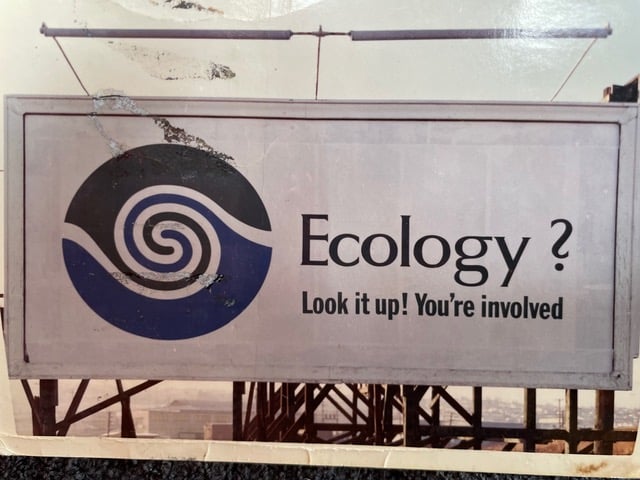I saw the danger / yet I walked / along the enchanted way.
— Patrick Kavanagh, Raglan Road, 1946
Over the past few decades a recurring question arises in public ecological discourse: In the face of overwhelming evidence, scientific warnings, existential urgency, and countless examples of ecological disintegration, why are societies worldwide so slow to respond appropriately?
Why, fifty years after the Limits to Growth study, are we still not able to slow human expansion and consumption? Why, fifty years after the UN first raised the issue of human population stress, are we still quibbling about whether or not we should even discuss the delicate issue? Why — 80 years after Alice Hamilton’s Exploring The Dangerous Trades, and 60 years after Rachel Carson’s, Silent Spring — are we still flooding our environments and our bodies with toxins? Why — after 33 international climate meetings over 41 years, two centuries since science understood the greenhouse effect — are human carbon emissions still rising?
As a species, and as diverse societies, we’re acting like an immature student, who keeps avoiding a simple homework assignment. Except this is not an individual failure, but rather a vast, collective failure.
We can understand that large, complex systems, such as interacting societies of billions of people, are more complex than an individual, and that complexity certainly provides part of the answer to our question about humanity’s slow pace of change. However, there appear to be some built-in qualities of society that prevent us from changing our habits quickly. We often hear this called “social inertia,” an inherent resistance to change.
What is social inertia? Is it a real thing? And how do we overcome it?
Looking in the wrong places
We borrow the word “inertia” from physics, used by Johannes Kepler in the seventeenth century to describe a property of matter, which retains its existing motion until some force causes a change. Kepler borrowed from the Latin inertem, which means literally “without art,” meaning without skill, unable to act.
For society and the value of activism, this image provides a helpful metaphor. Without some force, a society resists change, continues its habitual path. In a social or individual context, we use “inertia” to talk about the fixed habits, rituals, or patterns that make change difficult, even when we see danger ahead.
The ecological science tells us “we have to change,” but how do we coordinate such a large-scale effort? Our ecological crisis is a global dilemma, and the human family is a complex super-organism comprising thousands of cultures, subcultures, religions, political interests, personal preferences, power blocs, communities, neighbourhoods, families, and vastly diverse individuals.
We have seen that great human efforts may restore a river in China, save an endangered species in Australia, reduce carbon emissions in a Canadian city, or preserve an estuary in South Africa. Nevertheless, on the global scale, every year, our world contains less fresh water resources, reduced biodiversity, increasing atmospheric CO2, and fewer wetland habitats. Globally, forests decline and deserts expand. Seabirds disappear and ocean plastic increases.
For ecologists, this can be depressing and debilitating. We prop ourselves up with “wins,” success stories, and hope, but privately, we may shake our heads in wonder. How does the inertia of our global society limit society’s ability to respond appropriately to our ecological crisis? What can we do about it? For that matter, what is this vague creature, “social inertia”?
Social Inertia quantified
We can think of public inertia as the momentum of societies, committed to certain ways of doing things. Corporations may want to appear “green,” but don’t want to sacrifice profits to do so. Individuals who want to live “more sustainable” lifestyles, may feel trapped by the demands of earning money and working within an unsustainable system. Some governments, for the benefit of their corporate patrons, actively work against ecological restoration. Other governments may want to do the right thing, but find they must compromise to retain support. Even environmental groups may feel constrained by their need to maintain support from people who may not fully appreciate the scale or urgency of our crisis. Most people may simply be too busy surviving to give much thought or time to the health of global ecosystems or wild nature.
The sum total of all these constraints comprise what we might call social inertia.
A recent scientific paper attempts to quantify one aspect of this inertia, the cumulative sum of all our past growth. The recent paper, “Past world economic production constrains current energy demands,” (Timothy Garrett, M. Grasselli, S. Keen, PLOS ONE, August 27, 2020) shows how past global economic growth actually inhibits current economic development, climate change mitigation, and other attempts to respond to ecological and human rights challenges.
I must warn you that this paper relies on a chain of integral calculus math formulas that may send your head spinning, and you might think, “What does all this mean?” However, you may simply read the “Conclusions” and get the point. To briefly explain what this study means and why it is important for our discussion about inertia, I’m going to tell you a bit about a previous study by the same authors.
In an earlier 2012 paper entitled “No way out? The double-bind in seeking global prosperity alongside mitigated climate change,” Garrett, at the University of Utah Department of Atmospheric Sciences, showed that our carbon emissions remain entirely linked to economic activity. Although global society has grown the contribution of solar and wind energy, economic activity has grown even faster than renewable energy sources. As a result, carbon emissions have also increased.
Garrett’s research showed that for every dollar of global economic growth (using constant 1990 US dollars) society required approximately 9.7 milliwatts of energy. Energy consumption creates economic activity, but in our current world, economic activity includes an embedded fossil-fuel energy cost. Embedded carbon-based energy represents the fossil fuel contribution to even renewable infrastructure (for resource mining, transportation, cement and steel production, and industrial fabrication). As a result, global society has not been able to actually decouple carbon emissions from economic growth, as some have hoped and advocated.
Global trade can obscure this fact of economics. Certain jurisdictions in the US and Europe, for example, have been able to reduce the carbon costs of economic growth, but they have achieved this primarily by exporting carbon-intensive industries (manufacturing, steel-making, cement production, mining) to Asia, South America, and Africa. As a result, global carbon emissions continue to grow in lockstep with economic growth. As far as global warming is concerned, only global emissions matter. National or regional carbon emissions are irrelevant to the state of Earth’s atmosphere.
In the more recent 2020 paper, Garrett and colleagues — Matheus Grasselli at McMaster University in Canada, and Stephen Keen at University College in London — go one step farther. Using 38 years of statistics from 1980 to 2017, their work shows how the energy that society requires today is proportional to the sum total of all past economic activity. The first study suggests that we cannot decouple energy demand from economic growth; this more recent study shows that we cannot decouple energy demand from all our accumulated, past economic growth and innovation.
This may seem kind of esoteric, but it is critical to understanding our ecological crisis, and the limits on global society’s ability to respond appropriately to our ecological crisis. The study quantifies one critical aspect of social inertia.
Civilizations have faced this dilemma in the past, as their size and complexity have outstripped their local resources. Empires amassed armies to occupy foreign lands and confiscate resources, but soon found out that the cost of doing so exceeded the reward. Ecologist and systems theorist Kenneth Boulding, who wrote about Evolutionary Economics in 1981, put it this way: “Imperialism makes the empire poor.” Growth never actually pays for what Boulding called “the metabolic cost” of an expanding empire. The unpaid debt is left behind as social and ecological decline.
In a recent video address, Dr. Mike Ryan, with the World Health Organization, linked this social debt and decline to the current Covid pandemic: “economic growth,” he states, “has become a malignancy … driving unsustainable practices. We’re writing cheques that we cannot cash, as a civilization, and they’re going to bounce, and our children are going to pay that price. We need a world … where profit is not put before communities.”
So what can we do?
Ecologists may understandably feel the weight of these realities, but there is no time for despair. We have to get on with the challenge of turning toward a genuinely ecological society.
In an online discussion about the 2020 Garrett paper, Natasha Léger, Executive Director of Colorado’s Citizens for a Healthy Community, wrote: “So now that cultural inertia is quantified, we need to quantify the friction (cultural, economic, environmental friction) to slow or stop the inertia.”
Social activism has long been the friction that slows and redirects societies’ inertia, whether that inertia maintains a failure of human rights, international peace, social justice, or ecology.
In recent decades, the global society at large has attempted to address the ecological crisis with technology. The IPCC, for example, relies on future, as yet unproven, carbon capture technologies to balance our emissions with economic growth. However, to date, this has not worked. Future technological solutions feel good, promising that we can continue growing our economies. We imagine solving our ecological and humanitarian crises without having to change our lifestyles.
These energy and economy studies, and our own disappointing track record, suggest that we’re avoiding the genuine root problems. The climate crisis, biodiversity collapse, toxic load, and humanitarian crises, are symptoms of larger, deeper problems, namely ecological overshoot, biophysical limits to growth. Successful species typically overshoot their habitats, as humanity has globally, but all genuine solutions to ecological overshoot include a contraction of scale. We must relinquish our expectation of endless economic growth. Sadly, reversing growth appears as the one solution ignored by most people, governments, corporations, and even some environmentalists.
These recent studies reveal this inevitable link between economic growth and ecological decline. Ecologists have known about ecosystem limits for decades, beginning at least with the 1972 Limits to Growth study. Now, when we do the full, global accounting, we discover that our technologies are not making us more ecologically efficient. Our technologies allow us to grow human impact faster. Some ecologists may remember in the 1980s when some people claimed computers were going to save paper. Globally, we now use six-times the amount of paper that we used at the dawn of the computer era. Growth swamps efficiency.
One of my communication mentors, decades ago, warned me that I would be sick and tired of repeating the ecological message before most people had even heard it, let alone understood it. She warned me to overcome the tedium and fatigue of the message, and find new, deeper ways to communicate. Wow. That turned out to be useful advice!
I suppose the lesson is: Hang in, don’t give up, keep on communicating and taking action for change. It can be a long haul, but we cannot afford to get discouraged. As the Chinese I Ching advises: “Perseverance furthers.”
Resources, Links:
T. Garrett, M. Grasselli, S. Keen, , “Past world economic production constrains current energy demands,” PLOS ONE, August 27, 2020.
T. J. Garrett, “No way out? The double-bind in seeking global prosperity alongside mitigated climate change,” Earth Systems Dynamics, 2012, Department of Atmospheric Sciences, University of Utah, Salt Lake City, Utah, USA
Corey Bradshaw, Paul Ehrlich, Eileen Crist, Joan Diamond, Anne H. Ehrlich, et al., “Underestimating the Challenges of Avoiding a Ghastly Future,” Frontiers of Conservation Science, 13 January 2021.
Vincent Moreau, “Decoupling energy use and economic growth: Counter evidence from structural effects and embodied energy in trade,” Applied Energy, 1 April 2018.
Kenneth Boulding, Evolutionary Economics, Sage Publications, 1981.
William E. Rees, Ecological economics for humanity’s plague phase,” Ecological Economics, 169, March 2020.
Dr. Mike Ryan, World Health Organization, video address, regarding ecological links to Covid pandemic, February, 2021.
Donnella Meadows, et al., Limits to Growth, Club of Rome, 1972.
Jørgen Stig Nørgård, John Peet, Kristín Vala Ragnarsdóttir, “The History of The Limits to Growth,” Solutions Journal, 2010.
William Catton, “Overshoot: The Ecological Basis of Revolutionary Change”, University of Illinois Press, 1982.
Jason Hickel, “New data proves you can support capitalism or the environment—but it’s hard to do both,” Foreign Policy, Sept. 12, 2018.
Vaclav Smil: “Harvesting the Biosphere: The Human Impact,” Population and Development Review 37(4), 2011, pdf.
Paul Chefurka, “Carrying Capacity and Overshoot, another look,” paulchefurka.ca




